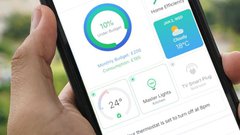Blame Brexit for rising energy prices
Hey! Looks like you have stumbled on the section of our website where we have archived articles from our old business model.
In 2019 the original founding team returned to run Next Investors, we changed our business model to only write about stocks we carefully research and are invested in for the long term.
The below articles were written under our previous business model. We have kept these articles online here for your reference.
Our new mission is to build a high performing ASX micro cap investment portfolio and share our research, analysis and investment strategy with our readers.
Click Here to View Latest Articles
While the cause of Australians’ energy-bill pain is largely due to a lack of competition and privatisation of energy providers, UK households’ is primarily brought on by Brexit and is why UK households face rising energy costs.
The results of the 2016 referendum has been the major factor driving up UK household energy prices over the past two years, driven largely by the collapse in the value of the pound and additional volatility in wholesale energy prices.
As a result, households paid an extra £75 each, on average, in the year after the vote following an 18% rise in wholesale electricity prices and a 16% gas price hike.
According to University College London research, Brexit has already added billions to the UK public’s energy bills and without a deal finalised it could cost the average household an extra £61 a year.
But while Australia suffers from a lack of energy competition, that’s far from a problem in the UK. There were more than 70 energy retailers operating in the UK market as of October 2018, a new record and a circa four-fold increase over the past decade.
This heightened competition is stimulated by the UK Government’s mandated rollout of smart electricity and gas meters, which continues to gather pace.
The government has identified smart meters as being a vital upgrade to Great Britain’s energy system. They offer a more efficient, greener, smarter energy system and lay the foundations for smart grids, which are a whole new way of running our energy networks.
For customers, smart meters help keep track of exactly how much gas and electricity they’re using in near real time, and what it costs.
The UK government wants energy suppliers to install smart meters in every home in England, Wales and Scotland. That amounts to more than 26 million homes for the energy suppliers to get to, with the goal of every home being offered a smart meter by 2020.
It has legislated deployment of 53 million smart electricity and gas meters to all homes and small businesses. Over 13 million smart meters have been installed, so far just 25% of the UK Government’s 2020 target.
The rollout is being led by energy suppliers, who are responsible for installing smart metering equipment.
By that time, the government requires energy suppliers to offer smart meters to all homes and small businesses across Great Britain. And while smart meters are not compulsory, more than four in five people who have a smart meter say they would recommend one.
The benefits of smart meters over other gadgets that can help control energy use, are that they show exactly how much energy you’re using and what it’s costing, in near real time, and they send accurate meter readings to energy suppliers. That means there’s no more estimated bills or manual meter readings.
ASX-listed Simble Solutions (ASX:SIS) has entered the UK utilities industry at a time of heightened competition within the space and rising demand for smart metres and value added technologies.
One such technology is SIS’s Virtual Analytics App. The app allows utilities to differentiate against competitors by offering smart analytics solutions to their customers, and use the data to identify and drive new revenue opportunities.
Smart meters and the smart grid form the foundation of the Virtual Analytics App, supplying the volumes of data from households and business.
The data infrastructure is managed by the Data Communications Company (DCC). The data is captured and analysed by Simble’s powerful machine learning technology, with the infrastructure and the array of means used to analyse information ranging from local diagnostic tools to highly complex planning instruments.
The insights are delivered to the end-used in a beautiful and responsive mobile application allowing utilities to engage, educate and empower their customers.
Simble’s technology offers utilities the ability to analyse customer attributes and behaviours and define customer groups by predictive criteria such as willingness to pay for specialised services or susceptibility to switching.
Yet the Virtual Analytics App, which it just launched into the UK residential market, is just one of SIS’s three key products, along with a Mobility suite that helps automate business processes and enable employees to work remotely, and the Simble Energy Platform.
The Simble Energy Platform, or ‘SimbleSense’, is an integrated hardware and real-time software solution that enables businesses to visualise, control and monetise their energy systems.
As opposed to most of its competitors, the platform is entirely hardware and network agnostic, meaning it can communicate with virtually any IoT device on any network — 3G, 4G, Sigfox, LoRa or WiFi based hubs and sensors. This opens up the door to an incredible world of IoT opportunities, which are constantly being assessed/validated in the background.
The company’s Software as a Service (SaaS) platform has Internet of Things (IoT) capabilities and empowers enterprises and consumers to remotely automate energy savings opportunities to reduce their energy bill.
Simble has emerged as the fastest growing energy software company on the ASX by number of site installations as a result of its partnership-led approach and unique IP. It has established technology and go-to market partnerships with industry leaders, allowing it to scale quickly and cost-effectively across multiple sector verticals.
In the UK, SIS partnered with Utiligroup, which offers a range of software solutions to help energy retailers enter and grow in the UK energy market. Utiligroup is the leading provider of services to next generation of utilities, servicing over 100 utilities and metering companies and handling data for over seven million underlying end-customers.
In Australia, Simble has become the first and only IoT software provider to partner with one of the world's largest IT distributors, Synnex. This relationship will facilitate its domestic and global expansion and provide access to 6000 resellers and potential partners. In October, the company announced that over $1 million in sales have been received to date — just scratching the surface of the potential sales velocity these partners can achieve.
General Information Only
S3 Consortium Pty Ltd (S3, ‘we’, ‘us’, ‘our’) (CAR No. 433913) is a corporate authorised representative of LeMessurier Securities Pty Ltd (AFSL No. 296877). The information contained in this article is general information and is for informational purposes only. Any advice is general advice only. Any advice contained in this article does not constitute personal advice and S3 has not taken into consideration your personal objectives, financial situation or needs. Please seek your own independent professional advice before making any financial investment decision. Those persons acting upon information contained in this article do so entirely at their own risk.
Conflicts of Interest Notice
S3 and its associated entities may hold investments in companies featured in its articles, including through being paid in the securities of the companies we provide commentary on. We disclose the securities held in relation to a particular company that we provide commentary on. Refer to our Disclosure Policy for information on our self-imposed trading blackouts, hold conditions and de-risking (sell conditions) which seek to mitigate against any potential conflicts of interest.
Publication Notice and Disclaimer
The information contained in this article is current as at the publication date. At the time of publishing, the information contained in this article is based on sources which are available in the public domain that we consider to be reliable, and our own analysis of those sources. The views of the author may not reflect the views of the AFSL holder. Any decision by you to purchase securities in the companies featured in this article should be done so after you have sought your own independent professional advice regarding this information and made your own inquiries as to the validity of any information in this article.
Any forward-looking statements contained in this article are not guarantees or predictions of future performance, and involve known and unknown risks, uncertainties and other factors, many of which are beyond our control, and which may cause actual results or performance of companies featured to differ materially from those expressed in the statements contained in this article. S3 cannot and does not give any assurance that the results or performance expressed or implied by any forward-looking statements contained in this article will actually occur and readers are cautioned not to put undue reliance on forward-looking statements.
This article may include references to our past investing performance. Past performance is not a reliable indicator of our future investing performance.




